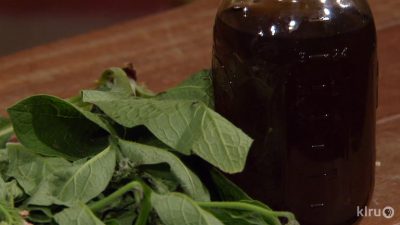Weed Teas

We spend our time weeding, so let’s make the weeds work for us! Fast-growing weeds are a rich source of nutrients NPK (nitrogen, potassium, and phosphorus) as well as hormones and trace minerals.
When we drink tea, we get the vitamins, minerals, and essential oils extracted from the plants thatour body takes up as nutrients. Plants do the same thing.
These teas are good for giving transplants a boost when they are actively growing.
Make a quick tea with chard, alfalfa or comfrey:
2 cups of coarsely chopped plant material added to a blender
Cover with hot water, blend thoroughly.
Strain with cheesecloth, coffee filter or pantyhose. Add the herbs to the compost pile or as mulch.
Cool the tea and use as a soil drench for indoor or outdoor plants.
Chard has calcium, phosphorus, vitamins A, B 12 and C and trace minerals.
Weed Feed Tea
Use what you have growing.Mix as many as possible for the best array of nutrients.
This can be messy and smelly keep away from the house but many organic fertilizers can be pretty smelly. People made their own fertilizers for centuries!
Some things to use: comfrey, chard, equisetum, lamb’s quarter, nettles, willow branches, chickweed, dandelions, dried and chopped egg shells, used coffee grounds and filters (especially for acid loving plants), cleavers, chamomile lawn clippings.
Coarsely chop the weeds and place in a mesh bag or just in the bucket. (The mesh bag strains out the larger particles and makes it easier to use the finished tea.)
Place in a five gallon bucket and cover with rainwater or chlorine-free water. Chlorine will kill the microbes that break down the plants.
Let stand for several days, up to 2 weeks. It’s pretty smelly, so keep away from the house! Place in the shade in summer months.
Cover to keep out mosquitos. Use screening, row cover or a tight lid. Stir every few days.
To use: Add one part tea to four or five parts water and water around plants, not on foliage. Don’t use on edible plants at harvest time. Add tea residue to compost pile.
Plant materials for weed feed brewing
Lamb’s quarter is very rich in calcium, beta-carotene and minerals.
Dandelions have deep tap roots that mine minerals from the soil.
Chicory rich in potassium, calcium, A vitamin.
Coffee grounds (used) and filters good source of nitrogen, phosphorus, potassium.
Comfrey good source of calcium, phosphorus, potassium, Vitamins A, C and trace minerals.
Perilla iron and calcium.
Alfalfa meal or rabbit pellets from the feed store can be added for growth hormones, sulfur, magnesium and many more trace elements.
Chamomile blooms help with damping off of new seedlings. Steep in cold water and spray on the soil surface as you water seedlings.
Most herbs are nutrient rich. Add stems or trimmings from plants to any tea blend.
Dandelion Vitamins A, C, calcium, potassium
Nettle A, C, B vitamins, calcium, potassium and trace minerals.
Parsley A, C, iron, copper, manganese.
Others for your weed teas:
Burdock
Chickweed
Sorrel
Plantain
Pigweed
Horsetail or Equisetum good source of selenium
Grass clippings
Weeds will have their highest nutrient content just before flowering. Use a wide variety of weeds in your tea blend to have the best array of nutrients in your tea.
categories:
tags:
related:
appeared on episodes:

 Trisha Shirey
Trisha Shirey